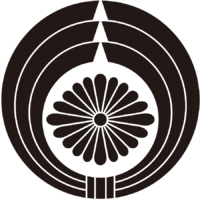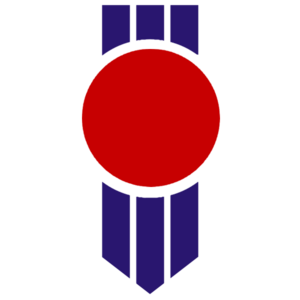Kogami Clan
Kogami Family 高上氏 (Kogami-shi) | |
|---|---|
 | |
| Indonesian name | Keluarga Prawirayuda |
| Korean name | 고가문 (Go-gamun) |
| Chinese name | 高上氏 (Gāo Shàng Shì) |
| Abbreviation | KGS, GSJ |
| Patriarch | Kojiro Kogami |
| Matriarch | |
| First Elder |
|
| Advisor | Miyajima Yuri (Mugen's younger sister) |
| Founder | Kojiro Kogami |
| Founded | July 17, 2043 (current form) |
| Style(s) |
|
| Estate(s) |
|
| Political position | Centre |
| Religion | Sunni Islam |
| Multiversal Affiliation | Divine Alliance |
| International Affiliation | Omega |
| Colours | Black |
| Slogan | "人と神の絆、人類の共生と導き" (English: The bond of humanity and the divine, coexistence and guidance for mankind.) |
| Introduction Theme | Henry Jackman - First Class |
| Entrance Theme | Ramin Djawadi - Driving With The Top Down |
| Battle Theme | Rob Dougan - Chateau |
| Battle Theme (Alternate) | Steve Jablonsky - Battle |
The Kogami Family (Japanese: 高上氏 Kogamishi) affectionately nicknamed the "南方出身の武道家" (Nanpō shusshin no budōka, "southern-born martial artists") is a renowned family that is known for being involved in the political, social and economic sector of Orientia.
Overview
The Kogami Family is a prominent family from Orientia. They're known as a family of education, business and arts. Many of the family members are educators who holds high positions in universities and schools throughout the country, for example, Kogami Kojiro is the President of Chiba University, while Kogami
The family crest of the Kogami Clan is a symbolic representation that carries deep meaning within the clan's identity. It consists of two essential elements: the abalone meat and the chrysanthemum.
The abalone meat signifies the family's inherent protective nature. It mirrors their commitment to safeguarding and nurturing those within their circle. This emblematic representation stands as a testament to the Kogami family's enduring role as guardians, encompassing their care and concern for the well-being of their community. Also, it signifies the clan's origin from the southern hemisphere, which reflects their roots while simultaneously emphasizing their growth and expansion across Orientia.
Alongside the abalone, the chrysanthemum conveys the twin values of significance and longevity that are at the core of the family's legacy. Just as the chrysanthemum thrives over time and holds cultural significance, the Kogami family's impact persists through generations.
History
The first seeds of the ideas that would once become the Kogami clan came to the mind of its founder and current Patriarch, Kogami Ken, following his naturalization to be a Japanese citizen in 2034. Seeing how his family was in the center of political disputes between his paternal and maternal family, he determined to establish a family clan that'd strengthen the position of his own family.
He established the clan in 2035, with him as the founding patriarch. His parents were supportive towards this move, and was given the titular position of "First Patriarch and Matriarch", despite Mugen being the actual patriarch. The name itself came from his own naturalized surname, and the Indonesian name was the combination of his paternal and his maternal family's unused surnames. His parents' name remained in their native language, with the Japanese names being used as an alias.
His paternal family (Syafi'i line descent from Yudawisastra family) and his maternal family (Wangsaprawira family), including his relatives were given the permission to get involved in the clan's matters, despite not having the surname.
Organization
Admission and Membership
The Kogami clan does not accept anyone with no blood relation as their member. However, they are more than open to anyone (from any gender and species) willing to cooperate, work for, and to join the clan through marriage. The process for anyone wishes to work for the family is not unlike job interviews; where applicants are required to fulfil some specific requirements (usually skill, academics related), interviewed and undergo some tests. For those who are willing to cooperate or join the clan through marriage, undergo a much relaxed process, where they only need to have an open discussion with the clan.
Those who passed the application process to work for the clan, are given the clan's handbook, and have to go through three weeks of internship in the Kogami Estate. After the internship, they will be given the clan's pin and a pair of smart glass or bracelet.
Structure
Mugen is the founder and current Patriarch of the Kogami Clan. Despite holding the positions of founder and patriarch, he is obligated to report to the First Elder and has the authority to make final decisions, including serving as the symbolic leader of the clan.
The Advisor provides support to the Patriarch while also reporting to the Council of Elders. Currently, the Advisor is Takabayashi Yuri (née Kogami), Mugen's own sister. The Council of Elders is comprised of the First Elders (former patriarchs and matriarchs, typically the parents of the current patriarch and matriarch) and the Second Elders (relatives from the first and second generations of incorporated families).
The Patriarch's relatives, including cousins and half-cousins, are granted the status of "Senators" and are permitted to participate as members of the "Clan Council." The Clan Council is responsible for discussing clan decisions made by the Patriarch that may or may not involve other relatives and families. Meetings are typically overseen by the Clan Advisor and operate in a manner similar to a parliamentary system in a country.
Patriarch Position
If the patriarch abdicates from his position, the Matriarch will replace him. If the Matriarch declines the position or abdicates from it, the clan leader's role will temporarily be assumed by the Advisor. The Advisor will then organize an election within a year, allowing the heirs from both the patriarch's family and his siblings' family to participate in the election for the Patriarch position. Only members of the Council of Elders and the Clan Council are permitted to vote. Individuals without the status of "Senator" or "Elder" cannot take part.
The children of the Patriarch's family and his siblings' family automatically hold the status of candidates for the position. The candidate with the most votes is selected as the next Patriarch, while the candidate with the second most votes assumes the role of the Advisor. If there are more than two candidates, the remaining candidates with fewer votes than the top two become members of the Clan Council. All candidates (except the winning candidate) are allowed to participate in the election only once. The abdicated Patriarchs and Matriarchs are automatically included as part of the First Elders.
In case of emergency situations, the First Elder(s) hold the highest authority.
Equipment
Clothing and accessories
Formal Attire
Kogami clan members are often seen wearing formal attire, such as black robe, with matching trousers and shoes for both genders. In formal occasions, members often wear kimono, with Ofurisode style for unmarried women and Tomesode for married women. The difference lies on the position of the patterns. While married men wears Kuromontsuki-haori-hakama , unmarried men wears the same kimono, but without the robe/Haori. Occasionally, members wear Batik to tribute their former homeland (that was nearly devastated in World War 3, and later incorporated to Amenria). A pin bearing the clan symbol is worn on the lapel. Members are permitted to use extra accessories such as hijab or eyewears. They may dye their hair if they want to do so.
Battle Attire
Members of the Kogami Clan wear specialized "Battle suits," resembling motorcycle suits but enhanced with fluorescent-like glowing strips that illuminate them. A typical battle suit is usually black, with the illuminated strips contrasting starkly against the dark bodysuit. Some are designed in white, incorporating glowing highlights over very light-colored apparel. A noteworthy feature of the more heavily armored suits is their ability to seamlessly blend into the structure of any vehicles, merging the suited rider with the vehicle as if they were a single cohesive unit. These black garments can also provide a helmet that rapidly forms around the wearer's head when triggered.
Vehicles
The Kogami clan owns a multitude of civilian vehicles. While most of the vehicles are owned by each member of the family, there are several land, water and aerial vehicles owned by the clan itself. Although, Mugen himself can be often seen using ex-military vehicles owned by the Reaper Guild.
Weapons
Kogami Clan's standard issue is the Light Chakram and the Light Baton. The Light Chakram is a Chakram made from steel with patterns encircling it to shape the user's Ki around it as the additional damage for the weapon. Meanwhile the Light Baton is Baton that uses the user's Qi to form a melee weapon based on the user's imagination; it can be a knife, a sword, a double edged sword, an axe, a spear, or even a halberd. The only limitation is its user's imagination and Qi strength. Other than these two standard weapons, clan members are also allowed to use ranged weapons such as energy guns or bows. Artifact weapons are off-limit to normal members and can only be used by the First Elders, the Patriarch and the Advisor.
Powers and Abilities
Fighting style
"Precision. Subtleness. Destroy from within."
- Kogami clan saying
The Kogami clan's martial arts are focused on precision. This is also the reason why most of the members of the clan are trained in either Kyokushin Karate or Taekwondo. While Kyokushin often aims for a powerful strikes, Kogami clan have adapted it to more focused on precisive movements that can destroy their enemies in a single fatal blow. The same goes for Taekwondo, as the clan's Taekwondo is more leaning towards ITF style of Taekwondo, where it emphasize on more traditional, comprehensive and precisive techniques. That being said, the clan only teaches it's members on how to achieve optimal physical condition for the style and basic techniques. Members are free to develop their own style which suits their body types, preferences, and conditions.
Gallery
Trivia
- Despite its organizational structure, the clan itself is generally egalitarian in nature and is not actually a noble or royal family, contrary to the Angelheart Family. All of its members were not of royal blood in their previous homeland (stripped their royal lineage before the 19th century due to the fall of the kingdoms under the Dutch rule).



